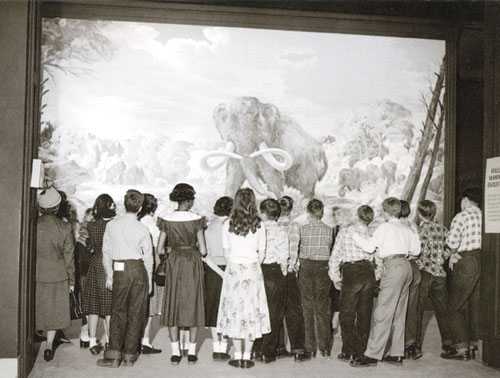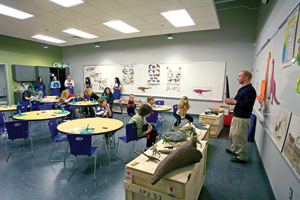 Spring 2008
Spring 2008Photo: Clyde Hare, 1951.Carnegie Museums’ Oakland facility, always a popular destination for school groups, now features a new Center for Museum Education.
|
Museums are classic places ofexploration for school kids. Here in Pittsburgh, generations of Pittsburghers still fondly recall their school field trips to the Oakland museums and the old Buhl Planetarium. Kids today will have memories of pop art and outer space from visits to The Warhol and Carnegie Science Center, as well.
With more than 11,000 square feet of new and renovated space, the center is capable of accommodating even more summer campers "Museum educators are thrilled to have an area devoted to serving our primary audience, school groups," says Diane Grzybek, chair of education at Carnegie Museum of Natural History. "Since the center addresses their unique needs, teachers and children feel important and valued as museum visitors. This positive, supportive environment sets the stage for children to begin to learn about the wonders of natural history both in the museum and in the classrooms. With expanded programming, especially related to Dinosaurs in Their Time, we plan on welcoming 50,000 school children through the center in 2008." |
Traveling Warhol · The Art of Being Human · The Explorers Club · Seeing Stars · The Future is Now · Director's Note · NewsWorthy · Now Showing · Face Time: Matt Wrbican · Science & Nature: A Scoop Full · Artistic License: Animal Attraction · First Person: Full Body Experience
 |
Copyright © 2017 CARNEGIE Magazine. All rights reserved. |


 But visits to today’s Carnegie Museums aren’t just about springtime field trips. Now more than ever, the four museums are collaborating with local schools to create educational experiences that complement what’s happening in the classroom—and, in some cases, take the place of the in-school classroom. For that reason, an important project funded by Carnegie Museums’ successful Building the Future campaign was the creation of a Center for Museum Education in Oakland, built in the basement of the Oakland facility, beneath the new Jurassic Atrium in Dinosaurs in Their Time. Not only does the center provide a safe, quiet, and private space for school children and their teachers to enter and become oriented to the museums, but it’s a dedicated education facility, as well.
But visits to today’s Carnegie Museums aren’t just about springtime field trips. Now more than ever, the four museums are collaborating with local schools to create educational experiences that complement what’s happening in the classroom—and, in some cases, take the place of the in-school classroom. For that reason, an important project funded by Carnegie Museums’ successful Building the Future campaign was the creation of a Center for Museum Education in Oakland, built in the basement of the Oakland facility, beneath the new Jurassic Atrium in Dinosaurs in Their Time. Not only does the center provide a safe, quiet, and private space for school children and their teachers to enter and become oriented to the museums, but it’s a dedicated education facility, as well.